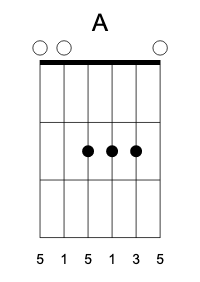

Guitar Decomposed: 6. Dominant Seventh Chords
source link: https://bartoszmilewski.com/2020/05/28/guitar-decomposed-6-dominant-seventh-chords/
Go to the source link to view the article. You can view the picture content, updated content and better typesetting reading experience. If the link is broken, please click the button below to view the snapshot at that time.

Previously, we discussed chord construction by mutating the third (we’ll come back to the topic of mutating the fifth later). Another important mutation is adding more notes to a chord. Traditionally, the most common addition is that of the seventh. There are two versions of the seventh: minor, consisting of 10 semitones; and major, 11 semitones. We’ll start with the minor mutation, because it plays a very important role in functional harmony.
Classical music was built around the idea of tension and resolution, and the perfect expression of it was the authentic cadence, a two chord progression from the dominant chord to the tonic. The dominant is the fifth above the tonic so, for instance, E dominates A. You could build a whole song with just these two chords, and you’d probably end it on the cadence from E to A (the word cadence is derived from cadere, which means to fall).
To add more tension to a dominant chord, it is customary to extend it with a minor seventh. This creates a very dissonant interval between it and the third of the chord. The major third is 4 semitones above the root, the minor seventh is 10 semitones from the root, and 10 – 4 = 6. Six semitones is a diminished fifth, or the cursed tritone. The resolution of the tension created by this dissonance is very satisfying to our ears. A chord with a minor seventh is called the dominant seventh chord.
Let’s go back to the basic E shape and see how we can add a seventh to it.
We have two possibilities: we can either raise one of the fifth, or we can lower one of the roots. Luckily, both are duplicated, so we are not losing any triad tones.
Raising the fifth by three semitones (7 + 3 = 10) produces this grip:
Notice how smoothly it resolves down to the A chord by small movements of notes in opposite directions.
Here’s the alternative grip of E7, obtained by lowering the root (or the octave: 12 – 2 = 10) by two semitones:
This is a two-finger shape, and it’s easily transposed to any position on the fretboard. Alternatively, if you’re willing to skip the repeated fifth and the duplicated root, you may use this “jazzy” movable shape– here to voice a G7 at the third fret:
We can also add the minor seventh to minor chords to obtain minor seventh chords (sometimes called minor minor seventh chords). These are not as dissonant as their major counterparts (no tritone).
Again, we have two options, one of them easily movable across the fretboard
You can also mute the fifth in the second grip and obtain this strange chord:
This grip is often used in jazz, transposed across the fretboard, with either the top E string muted, or with both bass strings muted.
The story for the dominant seventh versions of the A chord is very similar:
And these are its two minor versions:
The D chords have only one dominant seven version each, obtained by lowering the root (octave):
And here’s the G7 chord in its usual shape, together with the truncated version which, incidentally, could be identified with the A7 chord shifted by two frets in the “wrong” direction:
We’ve seen the minor version of G seventh, Gm7, earlier.
There is only one version of C7:
Interestingly, it’s variation (the one with the fifth on the E string) can be shifted by one fret towards the nut to produce the B7 chord:
This new shape can, in turn, undergo further mutations, giving rise to other interesting extended chords.
As I said, dominant seventh chords have a strong tendency to resolve to their tonic chords, so it pays to learn at least part of the so called circle of fifths. Each chord in this list dominates the one to its right: B, E, A, D, G, C, F (followed by the sharped/flatted chords, to make the full circle of 12). The neighbor to the right of a given chord is called its subdominant. For instance E7 is the dominant of A, whose subdominant is D. The whole 12 bar blues can be played with any three consecutive chords picked from the circle of fifths.
Next time: major seventh chords.
Recommend
About Joyk
Aggregate valuable and interesting links.
Joyk means Joy of geeK



















